brake light YAMAHA MT-25 2016 Owners Manual
[x] Cancel search | Manufacturer: YAMAHA, Model Year: 2016, Model line: MT-25, Model: YAMAHA MT-25 2016Pages: 96, PDF Size: 5.16 MB
Page 6 of 96
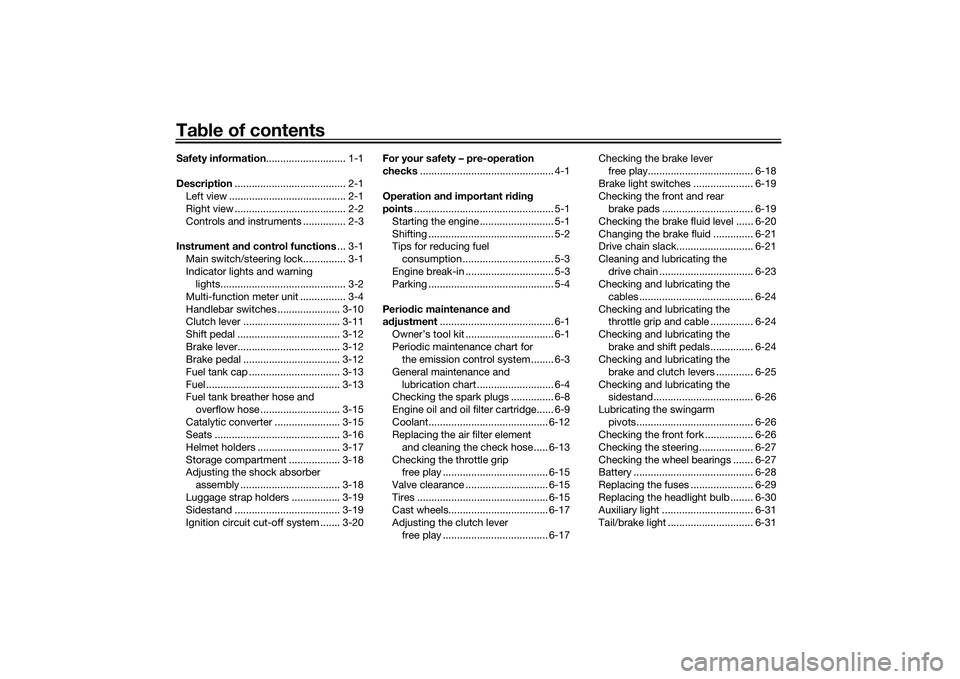
Table of contentsSafety information............................ 1-1
Description....................................... 2-1
Left view ......................................... 2-1
Right view ....................................... 2-2
Controls and instruments ............... 2-3
Instrument and control functions... 3-1
Main switch/steering lock............... 3-1
Indicator lights and warning
lights............................................ 3-2
Multi-function meter unit ................ 3-4
Handlebar switches ...................... 3-10
Clutch lever .................................. 3-11
Shift pedal .................................... 3-12
Brake lever.................................... 3-12
Brake pedal .................................. 3-12
Fuel tank cap ................................ 3-13
Fuel ............................................... 3-13
Fuel tank breather hose and
overflow hose ............................ 3-15
Catalytic converter ....................... 3-15
Seats ............................................ 3-16
Helmet holders ............................. 3-17
Storage compartment .................. 3-18
Adjusting the shock absorber
assembly ................................... 3-18
Luggage strap holders ................. 3-19
Sidestand ..................................... 3-19
Ignition circuit cut-off system ....... 3-20For your safety – pre-operation
checks............................................... 4-1
Operation and important riding
points................................................. 5-1
Starting the engine .......................... 5-1
Shifting ............................................ 5-2
Tips for reducing fuel
consumption ................................ 5-3
Engine break-in ............................... 5-3
Parking ............................................ 5-4
Periodic maintenance and
adjustment........................................ 6-1
Owner’s tool kit ............................... 6-1
Periodic maintenance chart for
the emission control system ........ 6-3
General maintenance and
lubrication chart ........................... 6-4
Checking the spark plugs ............... 6-8
Engine oil and oil filter cartridge...... 6-9
Coolant.......................................... 6-12
Replacing the air filter element
and cleaning the check hose..... 6-13
Checking the throttle grip
free play ..................................... 6-15
Valve clearance ............................. 6-15
Tires .............................................. 6-15
Cast wheels................................... 6-17
Adjusting the clutch lever
free play ..................................... 6-17Checking the brake lever
free play..................................... 6-18
Brake light switches ..................... 6-19
Checking the front and rear
brake pads ................................ 6-19
Checking the brake fluid level ...... 6-20
Changing the brake fluid .............. 6-21
Drive chain slack........................... 6-21
Cleaning and lubricating the
drive chain ................................. 6-23
Checking and lubricating the
cables ........................................ 6-24
Checking and lubricating the
throttle grip and cable ............... 6-24
Checking and lubricating the
brake and shift pedals............... 6-24
Checking and lubricating the
brake and clutch levers ............. 6-25
Checking and lubricating the
sidestand................................... 6-26
Lubricating the swingarm
pivots......................................... 6-26
Checking the front fork ................. 6-26
Checking the steering................... 6-27
Checking the wheel bearings ....... 6-27
Battery .......................................... 6-28
Replacing the fuses ...................... 6-29
Replacing the headlight bulb ........ 6-30
Auxiliary light ................................ 6-31
Tail/brake light .............................. 6-31UB04E0E0.book Page 1 Wednesday, September 2, 2015 3:51 PM
Page 14 of 96

Description
2-2
2
EAU10421
Right view
1
98 76 5 23
4
1. Fuse box (page 6-29)
2. Battery (page 6-28)
3. Fuel tank cap (page 3-13)
4. Headlight (page 6-30)
5. Engine oil filler cap (page 6-9)
6. Engine oil level check window (page 6-9)
7. Brake pedal (page 3-12)
8. Rear brake light switch (page 6-19)9. Rear brake fluid reservoir (page 6-20)UB04E0E0.book Page 2 Wednesday, September 2, 2015 3:51 PM
Page 49 of 96
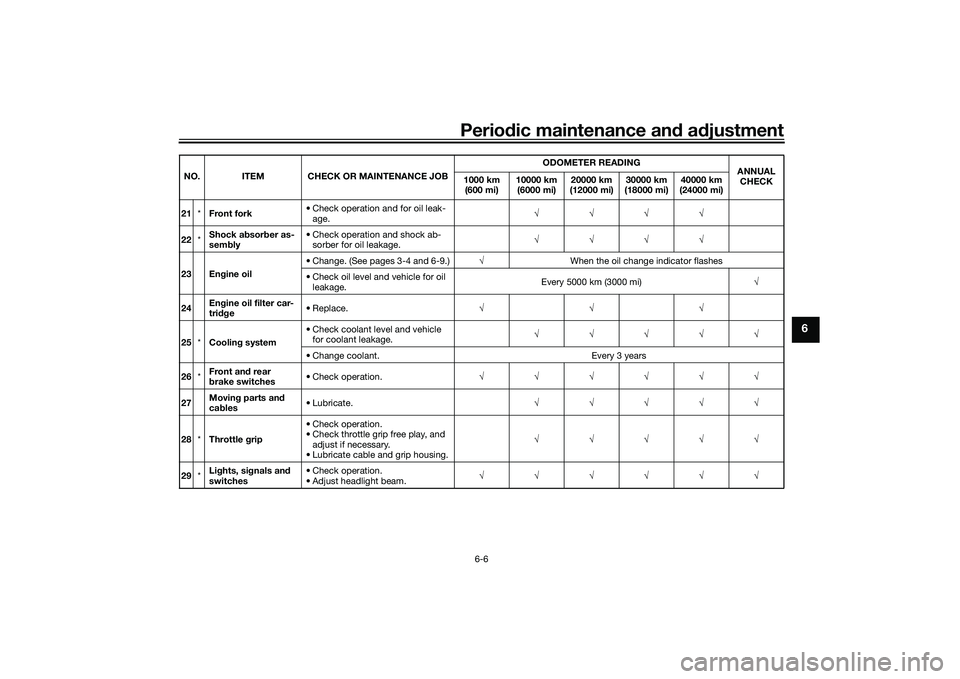
Periodic maintenance and adjustment
6-6
6
21*Front fork• Check operation and for oil leak-
age.√√√√
22*Shock absorber as-
sembly• Check operation and shock ab-
sorber for oil leakage.√√√√
23 Engine oil• Change. (See pages 3-4 and 6-9.)√When the oil change indicator flashes
• Check oil level and vehicle for oil
leakage.Every 5000 km (3000 mi)√
24Engine oil filter car-
tridge•Replace.√√√
25*Cooling system• Check coolant level and vehicle
for coolant leakage.√√√√√
• Change coolant. Every 3 years
26*Front and rear
brake switches• Check operation.√√√√√√
27Moving parts and
cables• Lubricate.√√√√√
28*Throttle grip• Check operation.
• Check throttle grip free play, and
adjust if necessary.
• Lubricate cable and grip housing.√√√√√
29*Lights, signals and
switches• Check operation.
• Adjust headlight beam.√√√√√√ NO. ITEM CHECK OR MAINTENANCE JOBODOMETER READING
ANNUAL
CHECK 1000 km
(600 mi)10000 km
(6000 mi)20000 km
(12000 mi)30000 km
(18000 mi)40000 km
(24000 mi)
UB04E0E0.book Page 6 Wednesday, September 2, 2015 3:51 PM
Page 62 of 96
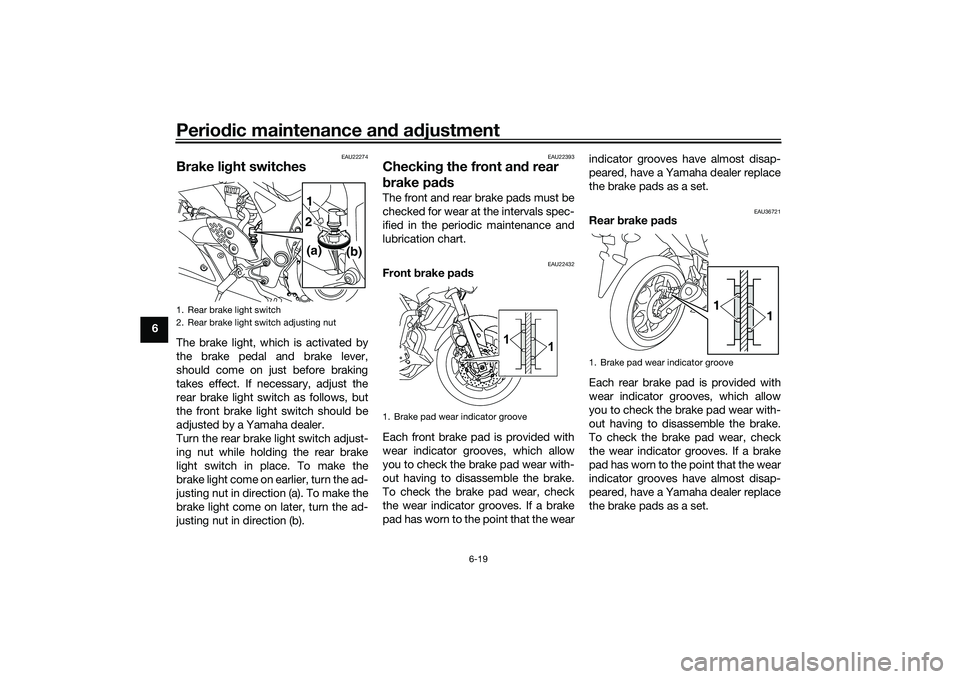
Periodic maintenance and adjustment
6-19
6
EAU22274
Brake light switchesThe brake light, which is activated by
the brake pedal and brake lever,
should come on just before braking
takes effect. If necessary, adjust the
rear brake light switch as follows, but
the front brake light switch should be
adjusted by a Yamaha dealer.
Turn the rear brake light switch adjust-
ing nut while holding the rear brake
light switch in place. To make the
brake light come on earlier, turn the ad-
justing nut in direction (a). To make the
brake light come on later, turn the ad-
justing nut in direction (b).
EAU22393
Checking the front and rear
brake padsThe front and rear brake pads must be
checked for wear at the intervals spec-
ified in the periodic maintenance and
lubrication chart.
EAU22432
Front brake pads
Each front brake pad is provided with
wear indicator grooves, which allow
you to check the brake pad wear with-
out having to disassemble the brake.
To check the brake pad wear, check
the wear indicator grooves. If a brake
pad has worn to the point that the wearindicator grooves have almost disap-
peared, have a Yamaha dealer replace
the brake pads as a set.
EAU36721
Rear brake pads
Each rear brake pad is provided with
wear indicator grooves, which allow
you to check the brake pad wear with-
out having to disassemble the brake.
To check the brake pad wear, check
the wear indicator grooves. If a brake
pad has worn to the point that the wear
indicator grooves have almost disap-
peared, have a Yamaha dealer replace
the brake pads as a set.
1. Rear brake light switch
2. Rear brake light switch adjusting nut
(a)
(b)1
2
1. Brake pad wear indicator groove
1 1
1. Brake pad wear indicator groove
1
1
UB04E0E0.book Page 19 Wednesday, September 2, 2015 3:51 PM
Page 74 of 96

Periodic maintenance and adjustment
6-31
6
EAU44941
Auxiliary lightThis model is equipped with an LED-
type auxiliary light.
If the auxiliary light does not come on,
have a Yamaha dealer check it.
EAU24182
Tail/brake lightThis model is equipped with an LED-
type tail/brake light.
If the tail/brake light does not come on,
have a Yamaha dealer check it.
EAU62590
Replacing a turn signal light
bulb1. Remove the turn signal light lens
by removing the screw.
2. Remove the turn signal light bulb
socket (together with the bulb) by
turning it counterclockwise.
1. Auxiliary light
1 1
1. Turn signal light lens
2. Screw
1
2
UB04E0E0.book Page 31 Wednesday, September 2, 2015 3:51 PM
Page 78 of 96
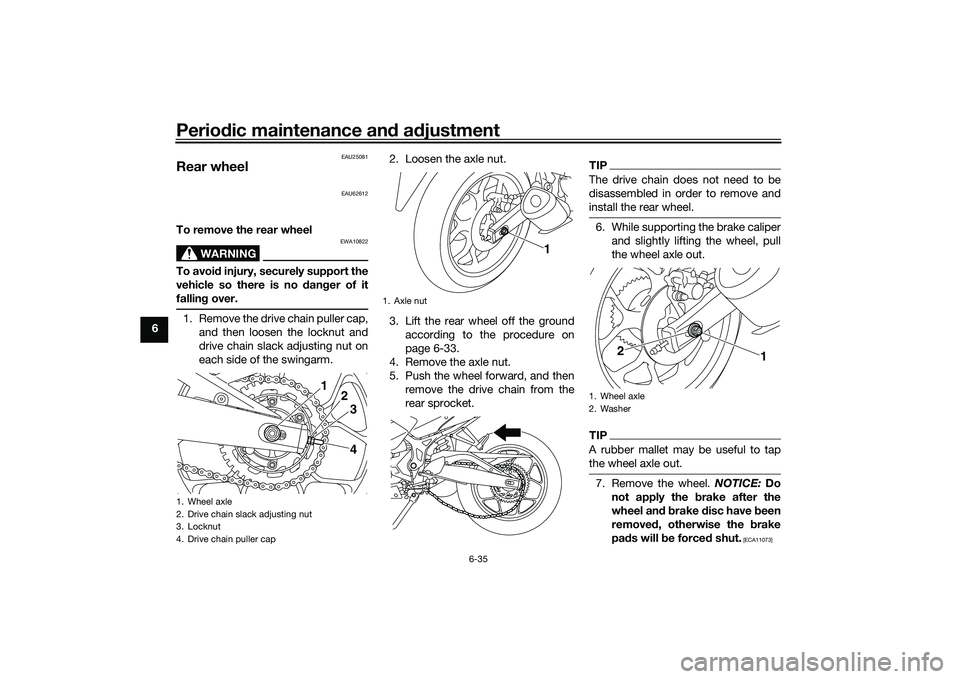
Periodic maintenance and adjustment
6-35
6
EAU25081
Rear wheel
EAU62612
To remove the rear wheel
WARNING
EWA10822
To avoid injury, securely support the
vehicle so there is no danger of it
falling over.1. Remove the drive chain puller cap,
and then loosen the locknut and
drive chain slack adjusting nut on
each side of the swingarm.2. Loosen the axle nut.
3. Lift the rear wheel off the ground
according to the procedure on
page 6-33.
4. Remove the axle nut.
5. Push the wheel forward, and then
remove the drive chain from the
rear sprocket.
TIPThe drive chain does not need to be
disassembled in order to remove and
install the rear wheel.6. While supporting the brake caliper
and slightly lifting the wheel, pull
the wheel axle out.TIPA rubber mallet may be useful to tap
the wheel axle out.7. Remove the wheel. NOTICE: Do
not apply the brake after the
wheel and brake disc have been
removed, otherwise the brake
pads will be forced shut.
[ECA11073]
1. Wheel axle
2. Drive chain slack adjusting nut
3. Locknut
4. Drive chain puller cap
342
1
1. Axle nut
1
1. Wheel axle
2. Washer
1 2
UB04E0E0.book Page 35 Wednesday, September 2, 2015 3:51 PM
Page 79 of 96

Periodic maintenance and adjustment
6-36
6 To install the rear wheel
1. Install the wheel and the brake cal-
iper bracket by inserting the wheel
axle from the left-hand side.
TIPMake sure that the slot in the
brake caliper bracket is fit over the
retainer on the swingarm.
Make sure that there is enough
space between the brake pads
before installing the wheel.2. Install the drive chain onto the rear
sprocket.
3. Install the axle nut.4. Lower the rear wheel so that it is
on the ground, and then put the
sidestand down.
5. Adjust the drive chain slack. (See
page 6-21.)
6. Tighten the axle nut, and then
tighten the locknuts to the speci-
fied torques.
7. Install the drive chain puller caps.
EAU25872
TroubleshootingAlthough Yamaha motorcycles receive
a thorough inspection before shipment
from the factory, trouble may occur
during operation. Any problem in the
fuel, compression, or ignition systems,
for example, can cause poor starting
and loss of power.
The following troubleshooting charts
represent quick and easy procedures
for checking these vital systems your-
self. However, should your motorcycle
require any repair, take it to a Yamaha
dealer, whose skilled technicians have
the necessary tools, experience, and
know-how to service the motorcycle
properly.
Use only genuine Yamaha replace-
ment parts. Imitation parts may look
like Yamaha parts, but they are often
inferior, have a shorter service life and
can lead to expensive repair bills.
WARNING
EWA15142
When checking the fuel system, do
not smoke, and make sure there are
no open flames or sparks in the ar-
ea, including pilot lights from water
1. Retainer
2. Slot
1
2
Tightening torques:
Axle nut:
57 Nm (5.7 m·kgf, 41 ft·lbf)
Locknut:
16 Nm (1.6 m·kgf, 12 ft·lbf)
UB04E0E0.book Page 36 Wednesday, September 2, 2015 3:51 PM
Page 84 of 96
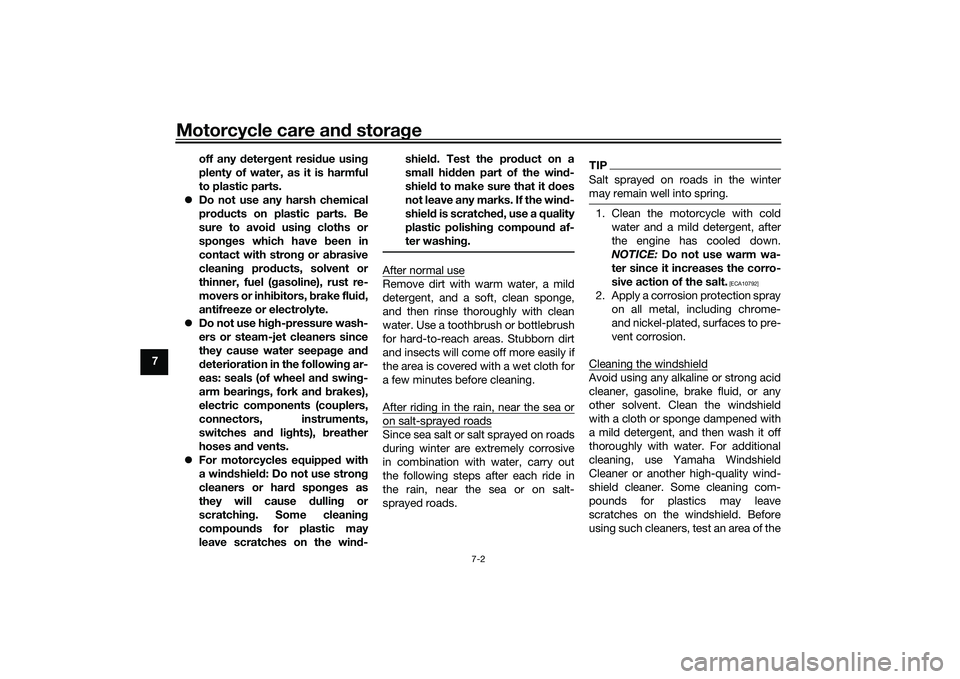
Motorcycle care and storage
7-2
7off any detergent residue using
plenty of water, as it is harmful
to plastic parts.
Do not use any harsh chemical
products on plastic parts. Be
sure to avoid using cloths or
sponges which have been in
contact with strong or abrasive
cleaning products, solvent or
thinner, fuel (gasoline), rust re-
movers or inhibitors, brake fluid,
antifreeze or electrolyte.
Do not use high-pressure wash-
ers or steam-jet cleaners since
they cause water seepage and
deterioration in the following ar-
eas: seals (of wheel and swing-
arm bearings, fork and brakes),
electric components (couplers,
connectors, instruments,
switches and lights), breather
hoses and vents.
For motorcycles equipped with
a windshield: Do not use strong
cleaners or hard sponges as
they will cause dulling
or
scratching. Some cleaning
compounds for plastic may
leave scratches on the wind-shield. Test the product on a
small hidden part of the wind-
shield to make sure that it does
not leave any marks. If the wind-
shield is scratched, use a quality
plastic polishing compound af-
ter washing.
After normal useRemove dirt with warm water, a mild
detergent, and a soft, clean sponge,
and then rinse thoroughly with clean
water. Use a toothbrush or bottlebrush
for hard-to-reach areas. Stubborn dirt
and insects will come off more easily if
the area is covered with a wet cloth for
a few minutes before cleaning.
After riding in the rain, near the sea oron salt-sprayed roadsSince sea salt or salt sprayed on roads
during winter are extremely corrosive
in combination with water, carry out
the following steps after each ride in
the rain, near the sea or on salt-
sprayed roads.
TIPSalt sprayed on roads in the winter
may remain well into spring.1. Clean the motorcycle with cold
water and a mild detergent, after
the engine has cooled down.
NOTICE: Do not use warm wa-
ter since it increases the corro-
sive action of the salt.
[ECA10792]
2. Apply a corrosion protection spray
on all metal, including chrome-
and nickel-plated, surfaces to pre-
vent corrosion.
Cleaning the windshieldAvoid using any alkaline or strong acid
cleaner, gasoline, brake fluid, or any
other solvent. Clean the windshield
with a cloth or sponge dampened with
a mild detergent, and then wash it off
thoroughly with water. For additional
cleaning, use Yamaha Windshield
Cleaner or another high-quality wind-
shield cleaner. Some cleaning com-
pounds for plastics may leave
scratches on the windshield. Before
using such cleaners, test an area of the
UB04E0E0.book Page 2 Wednesday, September 2, 2015 3:51 PM
Page 85 of 96

Motorcycle care and storage
7-3
7 windshield which does not affect your
visibility and which cannot be easily
recognized.
After cleaning
1. Dry the motorcycle with a chamois
or an absorbing cloth.
2. Immediately dry the drive chain
and lubricate it to prevent it from
rusting.
3. Use a chrome polish to shine
chrome, aluminum and stainless-
steel parts, including the exhaust
system. (Even the thermally in-
duced discoloring of stainless-
steel exhaust systems can be re-
moved through polishing.)
4. To prevent corrosion, it is recom-
mended to apply a corrosion pro-
tection spray on all metal,
including chrome- and nickel-plat-
ed, surfaces.
5. Use spray oil as a universal clean-
er to remove any remaining dirt.
6. Touch up minor paint damage
caused by stones, etc.
7. Wax all painted surfaces.
8. Let the motorcycle dry completely
before storing or covering it.
WARNING
EWA11132
Contaminants on the brakes or tires
can cause loss of control.
Make sure that there is no oil or
wax on the brakes or tires.
If necessary, clean the brake
discs and brake linings with a
regular brake disc cleaner or
acetone, and wash the tires with
warm water and a mild deter-
gent. Before riding at higher
speeds, test the motorcycle’s
braking performance and cor-
nering behavior.NOTICE
ECA10801
Apply spray oil and wax spar-
ingly and make sure to wipe off
any excess.
Never apply oil or wax to any
rubber and plastic parts, but
treat them with a suitable care
product.
Avoid using abrasive polishing
compounds as they will wear
away the paint.
TIPConsult a Yamaha dealer for ad-
vice on what products to use.
Washing, rainy weather or humid
climates can cause the headlight
lens to fog. Turning the headlight
on for a short period of time will
help remove the moisture from the
lens.
UB04E0E0.book Page 3 Wednesday, September 2, 2015 3:51 PM
Page 89 of 96

Specifications
8-2
8
6th:
0.920 (23/25)
Chassis:Frame type:
Diamond
Caster angle:
25.0 °
Trail:
95 mm (3.7 in)Front tire:Type:
Tubeless
Size:
110/70-17M/C (54S)
Manufacturer/model:
IRC/RX-01FRear tire:Type:
Tubeless
Size:
140/70-17M/C (66S)
Manufacturer/model:
IRC/RX-01RLoading:Maximum load:
160 kg (353 lb)
(Total weight of rider, passenger, cargo
and accessories)Tire air pressure (measured on cold
tires):1 person:
Front:
200 kPa (2.00 kgf/cm2, 29 psi)Rear:
225 kPa (2.25 kgf/cm2, 33 psi)
2 persons:
Front:
200 kPa (2.00 kgf/cm2, 29 psi)
Rear:
225 kPa (2.25 kgf/cm2, 33 psi)
Front wheel:Wheel type:
Cast wheel
Rim size:
17M/C x MT2.75Rear wheel:Wheel type:
Cast wheel
Rim size:
17M/C x MT4.00Front brake:Type:
Hydraulic single disc brake
Specified brake fluid:
DOT 4Rear brake:Type:
Hydraulic single disc brake
Specified brake fluid:
DOT 4Front suspension:Type:
Telescopic fork
Spring:
Coil spring
Shock absorber:
Hydraulic damperWheel travel:
130 mm (5.1 in)
Rear suspension:Type:
Swingarm
Spring:
Coil spring
Shock absorber:
Hydraulic damper
Wheel travel:
125 mm (4.9 in)Electrical system:System voltage:
12 V
Ignition system:
TCI
Charging system:
AC magnetoBattery:Model:
GTZ8V
Voltage, capacity:
12 V, 7.0 Ah (10 HR)Headlight:Bulb type:
Halogen bulbBulb wattage × quantity:Headlight:
H4, 60.0 W/55.0 W x 1
Brake/tail light:
LED
Front turn signal light:
10.0 W × 2
UB04E0E0.book Page 2 Wednesday, September 2, 2015 3:51 PM